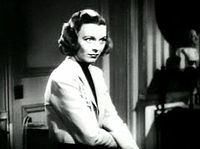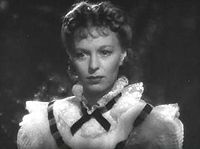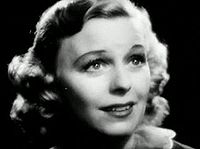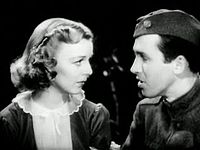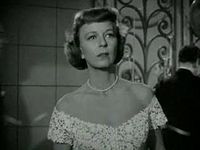- Margaret Sullavan
-
Margaret Sullavan
from The Shining Hour (1938)Born Margaret Brooke Sullavan
May 16, 1909
Norfolk, Virginia,
United StatesDied January 1, 1960 (aged 50)
New Haven, Connecticut,
United StatesOccupation Actress Years active 1929–1960 Spouse Henry Fonda (1931-1932)
William Wyler (1934-1936)
Leland Hayward (1936-1947)
Kenneth Wagg (1950-1960)Margaret Brooke Sullavan (May 16, 1909 – January 1, 1960; studio publicity incorrectly reported her year of birth as 1911)[1] was an American stage and film actress. Sullavan started her career on the stage in 1929. In 1933 she caught the attention of movie director John M. Stahl and had her debut on the screen that same year in Only Yesterday.
Margaret Sullavan preferred working on the stage and did only 16 movies. She retired from the screen in the early forties, but returned in 1950 to make her last movie, No Sad Songs For Me (1950), in which she plays a woman who is dying of cancer. For the rest of her career she would only appear on the stage.
Sullavan was nominated for an Academy Award for Best Actress for her performance in Three Comrades (1938). She died of an overdose of barbiturates on January 1, New Year's Day, 1960, at the age of 50.
Contents
Background
Sullavan was born in Norfolk, Virginia, the daughter of a wealthy stockbroker, Cornelius Sullavan and his wife, Garland Brooke. The first years of Margaret's childhood were spent isolated from other children. She suffered from a painful muscular weakness in the legs that prevented her from walking, so that she was unable to mingle with other children until the age of six. After recovery she emerged as an adventurous and tomboyish child who preferred playing with the children from the poorer neighborhood, much to the regrets of her class-conscious parents. [2]
She attended boarding school at Chatham Episcopal Institute (now Chatham Hall), where she was president of the student body and delivered the salutary oration in 1927. She moved to Boston and lived with her half-sister, Weedie, where she studied dance at the Boston Denishawn studio and (against her parents' wishes) drama at the Copley Theatre. When her parents cut her allowance to a minimum, Sullavan defiantly paid her way as a clerk in the Harvard Cooperative Bookstore (The Coop), located in Harvard Square, Cambridge.[3]
Early career
Sullavan succeeded in getting a chorus part in the Harvard Dramatic Society 1929 spring production Close Up, a musical written by Harvard senior and later Broadway and Hollywood composer Bernard Hanighen. The President of the Harvard Dramatic Society, Charles Leatherbee, along with the President of Princeton's Theatre Intime, Bretaigne Windust, who together had established the University Players on Cape Cod the summer before, persuaded Sullavan to join them for their second summer season. Another member of the University Players and one who had the comic lead in Close Up was Henry Fonda. In the summer 1929 Sullavan appeared opposite Fonda in The Devil in the Cheese, her debut on the professional stage. Sullavan returned for most of University Players's 1930 season. In 1931, she squeezed in one production with the University Players between the closing of the Broadway production of A Modern Virgin in July and its tour in September. She rejoined the University Players for most of its 18-week 1930-31 winter season in Baltimore.[4]
Sullavan's parents did not approve of her choice of career. However, in 1930 she played the lead in Strictly Dishonorable by Preston Sturges with her parents among the audience. Confronted with her evident talent their objections ceased. "To my deep relief", Sullavan later recalled. "I thought I'd have to put up with their yappings on the subject forever." [5] A Shubert scout saw her in that play as well and eventually she met Lee Shubert himself. At that moment Sullavan suffered from a bad case of laryngitis. Consequently, her voice was huskier than usual. Shubert loved it. In subsequent years Sullavan would joke that she cultivated that "laryngitis" into a permanent hoarseness by standing in every available draft.[5]
Sullavan made her debut on Broadway in A Modern Virgin (a comedy by Elmer Harris), on May 20, 1931. At one point in 1932 she starred in four Broadway flops in a row (If Love Were All, Happy Landing, Chrysalis (with Humphrey Bogart) and Bad Manners), but the critics praised Sullavan for her performances in all of them. [6]
In March 1933, Sullavan replaced another actor in Dinner at Eight in New York. Movie director John M. Stahl happened to be watching the play and was intrigued by Sullavan and decided she would be perfect for a picture he was planning, Only Yesterday. At that time Sullavan had already turned down offers from Paramount and Columbia for five-year contracts.[7] Sullavan was offered a three-year, two-pictures-a-year contract at $1,200 a week. She accepted it and had a clause put in her contract that allowed her to return to the stage on occasion.[8] Later on in her career Sullavan would only sign short-term contracts because she did not want to be "owned" by any studio.[9]
Hollywood
Sullavan arrived in Hollywood on May 16, 1933, her 24th birthday. Her film debut came that same year in Only Yesterday. Sullavan chose her scripts carefully. She was not satisfied with her performance in Only Yesterday. When she saw herself in the early rushes, she had been so appalled that she had tried to buy out her contract for $2,500, but Universal refused. In his November 10, 1933, review in The New York Herald Tribune, Richard Watts, Jr. wrote that Sullavan "plays the tragic and lovelorn heroine of this shrewdly sentimental orgy with such forthright sympathy, wise reticence and honest feeling that she establishes herself with some definiteness as one of the cinema people to be watched".[10] She followed that role with one in Little Man, What Now? (1934), which tells the story of a couple struggling to survive in the poverty of post–World War I Germany.
Originally, Universal had been reluctant to make a movie about unemployment, starvation and homelessness, but Little Man had been an important project to Sullavan. After Only Yesterday she wanted to try "the real thing". "It's a slice of life ... [L]ife as so many people are living it today in America and anywhere".[citation needed] She later said that it had been one of the few things she had done in Hollywood that gave her a great measure of satisfaction.[11]
The Good Fairy (1935) was a comedy that Sullavan, although not a natural comedienne, had insisted on doing to demonstrate her "wide-ranging versatility". During the production, she married its director, William Wyler.[12]
King Vidor's So Red the Rose (1935) dealt with the Civil War effects on the South and preceded Gone With the Wind by four years and Margaret Mitchell's novel by one year. Sullavan played a childish Southern-belle who matures into a responsible woman. The film also dealt with the situation of the freed black characters.
In Next Time We Love (1936), Sullavan plays opposite the then-unknown James Stewart. Sullavan had been campaigning for Stewart to be her leading man and the studio complied with her wish out of fear that she would otherwise stage a threatened strike.[13] The film dealt with a married couple that has grown apart over the years. The plot was unconvincing and simple, but the gentle interplay between Sullavan and Stewart saves the movie from being a soapy and sappy experience. Next Time We Love would be the beginning of one of Hollywood's most endearing partnerships, that of Sullavan and Stewart. They would eventually make four movies together.
In the comedy The Moon is Our Home (1936), Sullavan plays opposite her ex-husband Henry Fonda. The original script was rather pallid and Dorothy Parker and Alan Campbell were brought in to punch up the dialogue, reportedly at Sullavan's insistence. Sullavan and Fonda play a newly married couple and the movie is a cavalcade of insults and quips.
Sullavan's seventh film, Three Comrades (1938), is a drama set in post–World War I Germany. Three returning German soldiers meet Sullavan who joins them and eventually marries one of them. She gained an Oscar nomination for her role and was named the year's best actress by the New York Film Critics Circle.
Sullavan reunited with Stewart in The Shopworn Angel (1938). Stewart played a sweet, naive Texan soldier on his way to Europe (World War I) who marries Sullavan on the way. Her ninth film was the rather soapy The Shining Hour (1938), playing the suicidal sister to Joan Crawford. In The Shop Around the Corner (1940), Sullavan and Stewart worked together again, playing colleagues who do not get along at work, but have both responded to a lonely-hearts ad and are (without knowing it) exchanging letters with each other.
The Mortal Storm (1940) was the last movie Sullavan and Stewart ever did together. Sullavan is a young German girl engaged to a confirmed Nazi (Robert Young) in 1933. When she realizes the true nature of his political views, she breaks the engagement and turns her attention to anti-Nazi Stewart. Later, trying to flee the Nazi regime, Sullavan and Stewart attempt to ski across the border to safety in Austria. In the attempt Sullavan is gunned down by the Nazis (under orders from her ex-fiance). Stewart, at her request, picks her up and skis into Austria so she can die in a free country.
Back Street (1941) was lauded as one of the best performances of Sullavan's Hollywood career. She wanted Charles Boyer to play opposite her so much that she agreed to surrender top billing to him. Boyer plays a selfish and married banker and Sullavan his long-suffering mistress. Although he loves Sullavan, he is unwilling to leave his wife and family in favour of her.[14] So Ends Our Night (1941) is yet another wartime drama. Sullavan (on loan for a one-picture deal from Universal) plays a Jewish girl perpetually on the move with falsified passport and identification papers and always fearing that the officials will discover her game. On her way across Europe she meets up with a young Jewish boy (Glenn Ford) and the hunted couple falls in love.
A 1940 court decision obligated Sullavan to fulfill her original 1933 Universal agreement. Two additional pictures were made legal "musts". Back Street (1941) had been the first and as Universal long had been urging a light comedy on her, Appointment for Love (1941) would be Sullavan's last picture with that company. In the film, Sullavan appeared with Boyer again. Boyer's character marries Sullavan who tells him that his past affairs mean nothing to her. She insists that each have an apartment in the same building and that they meet only once a day, at 7 a.m.
Cry 'Havoc' (1943) is another war drama (World War II) but one of the rare all-female pictures. Sullavan plays the strong mother figure who keeps a bunch of ill-assorted nurses in line in a dugout in Bataan, while they are awaiting the advance of Japanese soldiers who are about to take over. It was the last film that Sullavan did with MGM. After its completion she was free of all movie commitments. She had often referred to MGM and Universal as "jails". When her husband, Leland Hayward, tried to read her the good reviews of Cry 'Havoc', she responded with usual bluntness: "You read them, use them for toilet paper. I had enough hell with that damned picture while making it - I don't want to read about it now!" [15]
Sullavan retired from films from 1943 to 1950 and concentrated on her family and the stage. She came back to the screen in 1950 to do one last picture, No Sad Songs for Me. She played a fifties suburban wife and mother who learns that she will die of cancer within a year and who then determines to find a "second" wife for her soon-to-be-widower husband (Wendell Corey). Natalie Wood, then eleven, plays their daughter. After No Sad Songs for Me and its favorable reviews, Sullavan had a number of offers for other films, but she decided to concentrate on the stage for the rest of her career.
Sullavan had a reputation of being temperamental and straightforward. On one occasion Henry Fonda (then her ex-husband) had decided to take up a collection for the fireworks on July 4. When Sullavan refused to make a contribution, Fonda complained loudly to a fellow actor. Then Sullavan rose from her seat and doused Fonda from head to foot with a pitcher of ice water. Fonda made a stately exit, and Sullavan, composed and unconcerned, returned to her table and ate heartily. [16] Another of her blowups almost literally killed Sam Wood, one of the founders of the Motion Picture Alliance. Wood was a keen anti-Communist. He dropped dead from a heart attack shortly after a raging argument with Sullavan, who had refused to fire a writer on a proposed film on account of his left-wing views.[17] Louis B. Mayer always seemed wary and nervous in her presence. "She was the only player who outbullied Mayer", Eddie Mannix, MGM, later said of Sullavan. "She gave him the willies".[15]
James Stewart
Sullavan's co-starring roles with James Stewart are among the highlights of their respective early careers. In 1935, Sullavan had decided on doing Next Time We Love. She had strong reservations about the story, but she had to "work off the damned contract".[18] The script contained a role she thought might be ideal for Stewart.
It was years earlier, during a casual conversation with some fellow actors on Broadway that Sullavan first predicted that Stewart one day would become a major Hollywood star.[19] By 1936, Stewart was a contract player at MGM but getting only small parts in B-movies. At that time Sullavan worked for Universal and when she brought up Stewart's name, they were puzzled. The Universal casting-people had never heard of him. At Sullavan's suggestion Universal agreed to test him for her leading man and eventually he was borrowed from a willing MGM to star with Sullavan in Next Time We Love.
Stewart had been nervous and unsure of himself during the early stages of production. At that time he had only had two minor MGM parts which had not given him much camera experience. The director, Edward H. Griffith, began bullying Stewart. "Maggie, he's wet behind the ears", Griffith told Sullavan. "He's going to make a mess of things".[20] Sullavan believed in Stewart and spent the evenings coaching him and helping him scale down his awkward mannerisms and hesitant speech that were soon to be famous around the world. "It was Margaret Sullavan who made James Stewart a star", director Griffith later said. "And she did, too", Bill Grady from MGM agreed. "That boy came back from Universal so changed I hardly recognized him".[21]
The inevitable gossip in Hollywood at that time (1935–36) was that William Wyler, Sullavan's then-husband, was suspicious about his wife's and Stewart's private rehearsing together.[22] When Sullavan divorced Wyler in 1936 and married Leland Hayward that same year, they moved to a colonial house just a block down from Stewart.[23] Stewart's frequent visits to the Sullavan/Hayward home soon restoked the rumors of his romantic feelings for Sullavan.
Sullavan and Stewart's second movie together was The Shopworn Angel (1938). "Why, they´re red-hot when they get in front of a camera", Louis B. Mayer said about their onscreen chemistry. "I don't know what the hell it is, but it sure jumps off the screen".[24] Walter Pidgeon, who was part of the triangle in The Shopworn Angel later recalled: "I really felt like the odd-man-out in that one. It was really all Jimmy and Maggie ... It was so obvious he was in love with her. He came absolutely alive in his scenes with her, playing with a conviction and a sincerity I never knew him to summon away from her".[25] Eventually the duo would do four movies together from 1936-1940 (Next Time We Love, The Shopworn Angel, The Shop Around the Corner and The Mortal Storm).
Late career
Throughout her career, Sullavan seemed to prefer the stage to the movies. She felt that only on the stage could she improve her skills as an actor. "When I really learn to act, I may take what I have learned back to Hollywood and display it on the screen", she said in an interview in October 1936 (when she was doing Stage Door on Broadway between movies). "But as long as the flesh-and-blood theatre will have me, it is to the flesh-and-blood theatre I'll belong. I really am stage-struck. And if that be treason, Hollywood will have to make the most of it".[26]
Another reason for her early retirement from the screen (1943) was that she wanted to spend more time with her children, Brooke, Bridget and Bill (then 6, 4 and 2 years old). She felt that she had been neglecting them and felt guilty about it.[26] Sullavan would still do stage work on occasion. From 1943-44 she was the sexually inexperienced, but curious, Sally Middleton in The Voice of the Turtle (by John Van Druten) on Broadway and later in London (1947). After her short return to the screen in 1950 with No Sad Songs for Me, she did not return to the stage until 1952. Her choice then was as the suicidal Hester Collyer, who meets fellow sufferer Mr. Miller (played by Herbert Berghof) in The Deep Blue Sea by Terence Rattigan. Later, in 1953 she agreed to appear in Sabrina Fair by Samuel Taylor. Although 44 at the time she played the chauffeur's 23-year-old daughter, Sabrina Fairchild, co-starring with Joseph Cotten.[citation needed]
In 1955-56 Sullavan appeared in Janus, a comedy by playwright Carolyn Green. Sullavan played the part of Jessica who writes under the pen name Janus and Robert Preston played her husband. The play ran for 251 performances from November 1955 to June 1956. In the late fifties Sullavan's hearing and depression were getting worse. However, in 1959 she agreed to do Sweet Love Remembered by playwright Ruth Goetz. It was to be Sullavan's first Broadway appearance in four years. Rehearsals began on December 1, 1959. Sullavan had mixed emotions about a return to acting and her depression soon became clear to everyone: "I loathe acting", she said on the very day she started rehearsals. "I loathe what it does to my life. It cancels you out. You cannot live while you are working. You are a person surrounded by an unbreachable wall". [27] That was the last interview she gave. The play was to open on February 4, 1960. Sullavan died on January 1, 1960.
Margaret Sullavan was inducted, posthumously, into the American Theatre Hall of Fame in 1981.[28]
Marriages and family
Sullavan was married four times. She married Henry Fonda on December 25, 1931 in Baltimore, while both were performing with the University Players in its 18-week winter season there.[29] She was exactly four years Fonda's junior: they shared the birth date of May 16. However, Fonda's lack of experience and confidence did not go well with Sullavan[citation needed] and the marriage lasted only two months. Sullavan was then involved with Broadway producer Jed Harris for some time.
In late 1934, she married William Wyler, the director of her next movie, The Good Fairy (1935). Her second marriage lasted just over a year and they divorced in March 1936.
Sullavan's third husband was agent and producer Leland Hayward. Hayward had been Sullavan's agent since 1931 and their relationship had been deepening all through 1936; they had already become lovers, and Brooke, their "love child", had been conceived that October. They both wanted the baby and married on November 15, 1936.
With the birth of her first baby, Sullavan's personality mellowed and softened somewhat[citation needed]. Sullavan was to have a baby every other year - Brooke in 1937, Bridget in 1939 and Bill in 1941. Their marriage lasted about 11 years and ended when Sullavan discovered that Hayward was cheating on her with Slim Keith[citation needed]. At Sullavan's insistence, she and Hayward divorced in 1947, and three years later she married Kenneth Wagg, an English investment banker, to whom she was married at the time of her death.[30]
Sullavan's sons-in-law include actor/director/artist Dennis Hopper, the second husband of her daughter Brooke Hayward, and Peter Duchin, Brooke Hayward's third husband.
Illness and death
Margaret Sullavan suffered from the congenital hearing defect otosclerosis that worsened as she aged, making her more and more hard of hearing. Her voice had developed a throatiness because she could hear low tones better than high ones. From early 1957 Sullavan's hearing was worsening; she was becoming depressed and sleepless and often wandered about all night. She would often go to bed and stay there for days, her only words: "Just let me be, please".[31] Sullavan had kept her hearing problem largely hidden. On January 8, 1960 (one week after Sullavan's death), The New York Post reporter Nancy Seely wrote: "The thunderous applause of a delighted audience—was it only a dim murmur over the years to Margaret Sullavan? Did the poised and confident mien of the beautiful actress mask a sick fear, night after night, that she'd miss an important cue?"
In addition to her hearing defect, Sullavan's children, Brooke, and in particular Bridget and Bill, often proved rebellious and contrary. As a result of the divorce from Hayward, the family fell apart. Sullavan felt that Hayward was trying to alienate their children from her. When the children went to California to visit their father they were so spoiled with expensive gifts that, when they returned to their mother in Connecticut, they were deeply discontented with what they saw as a staid lifestyle.[32]
By 1955, when Sullavan's two younger children told their mother that they preferred to stay with their father permanently, she suffered a nervous breakdown. Sullavan's older daughter, Brooke, in 1977 wrote about the breakdown in her autobiography Haywire: Sullavan had humiliated herself by begging her son to stay with her. He remained adamant and his mother had started to cry. "This time she couldn't stop. Even from my room the sound was so painful I went into my bathroom and put my hands on my ears".[33] In another scene from the book, a friend of the family (Millicent Osborne) had been alarmed by the sound of whimpering from the bedroom: "She walked in and found mother under the bed, huddled up in a fetal position. Kenneth was trying to get her out. The more authoritative his tone of voice, the farther under she crawled. Millicent Osborne took him aside and urged him to speak gently, to let her stay there until she came out of her own accord".[34] Eventually Sullavan agreed to spend some time (two and a half months) in a private mental institution. Her two younger children also spent time in various institutions.
Death
On January 1, 1960, at about 5:30 p.m., Sullavan was found in bed, barely alive and unconscious, in a hotel room in New Haven, Connecticut. Her copy of the script to Sweet Love Remembered, in which she was then starring during its tryout in New Haven, was found open beside her. Sullavan was rushed to Grace New Haven Hospital, but shortly after 6:00 p.m. she was pronounced dead. No note had been found to indicate suicide, and no conclusion was reached as to whether her death was the result of a deliberate or an accidental overdose.[35] The death was later identified as apparent suicide.[36] The county coroner, however, officially ruled the death an accident. A few days before she died, in her final interview, she said: "Theater can be a very horrible, cruel place!" Sullavan was interred at Saint Mary's Whitechapel Episcopal Churchyard, Lancaster, Virginia.[37]
Children's deaths
Sullavan's daughter Bridget was found dead in her apartment only nine months after her mother had died; she died at the age of 21 (of an overdose). Sullavan's son Bill committed suicide in 2008 at the age of 66.
Haywire
Sullavan's older daughter, actress Brooke Hayward, wrote Haywire, a best-selling memoir about her family, which was made into a television movie starring Lee Remick.
Filmography
References
- ^ Lawrence J. Quirk, Child of Fate - Margaret Sullavan, St. Martin's Press, New York, 1986, ISBN 0-312-51442-5, p. 5
- ^ Lawrence J. Quirk, pp. 5-7
- ^ Lawrence J. Quirk, p. 14.
- ^ Houghton, Norris. But Not Forgotten: The Adventure of the University Players. New York, William Sloan Associates, 1951.
- ^ a b Lawrence J. Quirk, p. 18.
- ^ Lawrence J. Quirk, p. 24
- ^ Hayward, Brooke. Haywire. Jonathan Cape Ltd., London, 1977, ISBN 0-224-01426-9, p. 190.
- ^ Lawrence J. Quirk, p. 26
- ^ Lawrence J. Quirk, p. 83.
- ^ Lawrence J. Quirk, pp. 27-29.
- ^ Lawrence J. Quirk, pp. 31-35.
- ^ Lawrence J. Quirk, pp. 35, 44.
- ^ Dewey, Donald. James Stewart. Sphere, London, ISBN 978-0-7515-2160-3, p. 145.
- ^ Lawrence J. Quirk, p. 117.
- ^ a b Lawrence J. Quirk, p. 128.
- ^ Lawrence J. Quirk, p. 42.
- ^ Donald Dewey, p. 286.
- ^ Lawrence J. Quirk, p. 59.
- ^ Donald Dewey, p. 115.
- ^ Lawrence J. Quirk, p. 60.
- ^ Lawrence J. Quirk, pp. 60-61.
- ^ Lawrence J. Quirk, p. 62-63.
- ^ Hayward, Haywire. Jonathan Cape Ltd., p. 72.
- ^ Lawrence J. Quirk, p. 93.
- ^ Lawrence J. Quirk, p. 92.
- ^ a b Lawrence J. Quirk, p. 80.
- ^ Hayward, Haywire. Jonathan Cape Ltd., p. 279.
- ^ "26 Elected to the Theater Hall of Fame." The New York Times, March 3, 1981.
- ^ Houghton, pp. 254-257.
- ^ Lawrence J. Quirk, pp. 74, 75, 90.
- ^ Lawrence J. Quirk, p. 163.
- ^ Lawrence J. Quirk, pp. 154-55.
- ^ Hayward, Haywire. Jonathan Cape Ltd., p. 253.
- ^ Hayward, Haywire. Jonathan Cape Ltd., pp. 258-259.
- ^ Lawrence J. Quirk, pp. 166-167.
- ^ One hundred great film performances you should remember, but probably don't By John DiLeo. Hal Leondard Corporation. p. 53
- ^ Margaret Sullavan at Find-A-Grave
Bibliography
- Hayward, Brooke (1977). Haywire. New York: Alfred A. Knopf. ISBN 0-394-49325-7.
External links
Categories:- 1909 births
- 1960 deaths
- Harvard University people
- American film actors
- American stage actors
- People from New Haven, Connecticut
- People from Norfolk, Virginia
- Actors who committed suicide
- Drug-related deaths in Connecticut
- 20th-century actors
Wikimedia Foundation. 2010.


